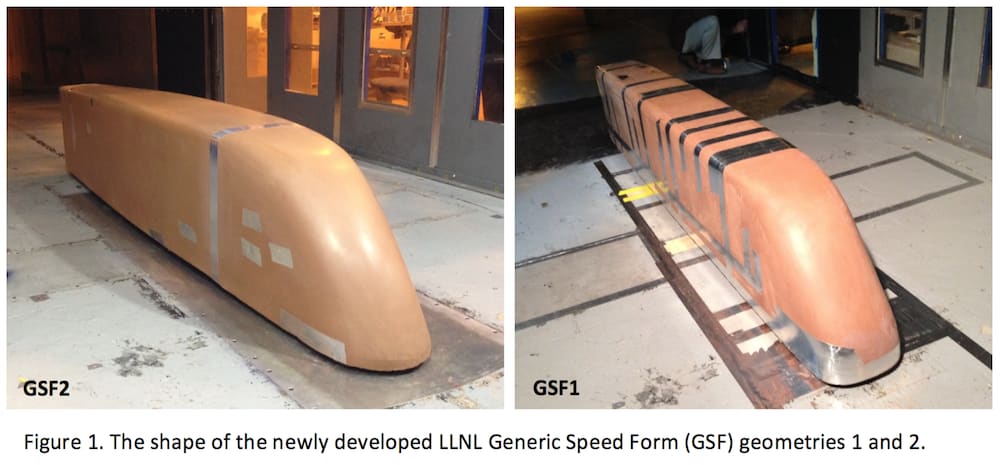
Introducing radically new, highly aerodynamic, and integrated Lawrence Livermore National Laboratory (LLNL) geometries for the design of the next-generation, class 8 heavy vehicles.
LLNL has a long history, since 1997, in developing and testing active and passive aerodynamic concepts for heavy vehicles (add-on devices) and more recently, has developed a fully integrated tractor-trailer geometry called Generic Speed Form (GSF).
Figure 1 presents the two new LLNL GSF geometries that represent a breakthrough in the aerodynamic performance of heavy vehicles. GSF2 has a more aggressive teardrop shape compared to GSF1. Both geometries have been extensively tested in the Army 7'x10' wind tunnel located at NASA Ames Research Center. The GSF2 aerodynamic performance results (Figure 2) shows 80% less drag at 0° yaw (crosswind angle) compared to a typical truck on the road. At 17° yaw, the GSF2 has no body-axis drag and, more notably, beyond 17° yaw, it has a negative drag coefficient, which means it produces a forward force in the direction of motion. These new geometries are generic and can easily be adopted by all tractor and trailer manufacturers for further development. A tractor manufacturer has already taken advantage of these geometries in design of their new products. Figure 2 presents the wind tunnel test results for GSF geometries compared to a typical truck on the road.
Based on the U.S. Department of Energy Transportation Energy Data Book, Class 7-8 tractor-trailers are responsible for 11% of the total U.S. consumption of petroleum. There are approximately 2.5 million combination trucks on the road today with an average fuel economy of 5.8 mpg. A 40% reduction in fuel consumption (80% drag reduction), which can be achieved by the proposed LLNL GSF2 geometry, translates into 11.2 billion gallons of diesel fuel saved per year and a reduction of 112 million tons of CO2 emissions. Given the U.S. average diesel price of $2.47 per gallon, the potential savings is about $27.6 billion per year.
Here are some interesting facts about a typical truck on a freeway doing 65 mph: over 50% of the usable vehicle engine output goes to overcome aerodynamic drag and over 30% goes to overcome the rolling resistance (tires). Hence, even a 2% drop in vehicle drag -- which is roughly equivalent to 1% reduction in fuel consumption -- is quite significant and would easily be adopted by fleets.
Prepared by LLNL under Contract DE-AC52-07NA27344 with IM release number LLNL-MI-733745.
-
Awards
-
 2017 Top 100 Entries
2017 Top 100 Entries
Like this entry?
-
About the Entrant
- Name:Kambiz Salari
- Type of entry:teamTeam members:Kambiz Salari (PI)
Jason Ortega - Software used for this entry:starccm+
- Patent status:none





